The Things We Wear, The Trinkets We Carry…
I wonder how many Vikings marched off to war in a shirt and trousers their mammies made for them? Last year the museum provided me with an outfit. This year however, I came prepared with an outfit made entirely by my own mother. Personal dress can often be the defining aspect of one’s culture or one’s own status. To Dickens’ musing, even poor Oliver Twist, in that single moment when newly born and wrapped in just a blanket, might have been the child of a nobleman or a beggar. But no stranger could have determined his role in society until he was enveloped in a pair of old calico robes, which had yellowed in the same service – badging and ticketing him as a parish child; a pauper; to be despised by all and pitied by none.
“I wonder how many Vikings marched off to war in a shirt and trousers their mammies made for them?”
The artefacts that once dressed and shaped the atmospheres of the past, are no longer in their original contexts. They have become darkened with age, time has removed them from the bustlings of daily life and they are left in places to stand, untouched and deadly silent. In the Longhouse however, atmosphere is everything, and if the atmosphere created here is anything similar to that of the original family’s in the 8th century, then it must have truly been a magnificent one. The dynamic here would not strictly be considered reenactment, neither is it the same as living history. But, by the time each visitor has reached the reconstructed longhouse, they have seen already the original objects from the excavations at Borg; now suspended in time behind glass. They have also seen the excavation site; a rather cold and windy excuse to see a large pockmarked crater of postholes.

Ancient objects are given a new life as tourists pass through the house – This photo by Kjell Ove Stork
But as you turn to enter the longhouse, which slowly looms over a hill of sheep and goats, your nose is first met by the aromas of burning firewood and a bubbling lamb stew; you begin to hear the sharp, staggered banging and scrapes of wood as you cross the threshold into the main entrance of the house. Almost immediately you are greeted by a guide dressed in the finery of a chieftain or a lady of some importance, while many bodies clothed in slacks and shirts of white linens or dresses and tunics of wool wrapped in cloaks, hurry about the place chatting to tourists and going about their daily duties.
“so too do the vibrant bright blues and yellows and the deep greens and reds pull you farther away from the black and brown leathers that Game of Thrones or The Lord of the Rings have left us used to”.
Most of the clothing worn by the staff is produced on site by the museum. Aside from woodworking and leather crafting, tablet weaving is a common site in the longhouse. Usually some of the girls can be seen weaving by our two looms; where often, many visitors will amusingly take one of the whale bone loom-swords and poise themselves with a shield and helmet for a photograph. Authentic clothing is what really makes the difference here. We of course learned about clothing in University, but my interests tended to sway towards the shinier, sharper things of the past. But the the mixed image of bright colours and textures tends to remove your thoughts from their usual comfort zones; much like how a multicoloured Roman column or statue tends to hurt the brain, so too do the vibrant bright blues and yellows and the deep greens and reds pull you farther away from the black and brown leathers that Game of Thrones or The Lord of the Rings have left us used to.

Guides of every language are placed around the house to answer questions and talk about the history and archaeology of the site.
This year however, I came with my own outfit. I certainly don’t feel of ‘higher status’ in the traditional sense, but having a dressmaker for a mother certainly made a few of my fellow Vikings quite jealous. Having usually worked on wedding and debutant dresses, my she was quite excited at trying something so old and so different. The first question was that of colour. Some colours in the past were of course more expensive than others and available to only those who had the means to wear them. Though I figured as I am ‘the Chieftain’s bow-maker’, I should probably dress more like a hunter; I therefore chose more earthy colours that would blend a bit more into the surrounding light green and boggy brown landscapes of Borg.
Last year I wore a pair of woollen trousers, but they proved far too heavy and hot for work. We chose then a lighter linen of dark brown. From the same material we then made a pare of leg ties that would hold in the looser ends of the trousers; keeping them from snagging on any low jutting branches in the woods.
The undershirt however, is of a really nice white linen. In keeping with the period, it has no collar, it is worn by pulling it over the head and reaches down to just above the knees. The tunic, my mother’s favourite article, was made from a really nice light brown wool. More or less the same design as the undershirt, it was made from 100% wool and is extremely warm, a detail I would easily have made use of when sailing on the longship last year. Sewn around the edge of the neck is a thin tablet woven trimming. Tablet weaving is another activity often practiced by the fire in the longhouse; several rocks hold in place the ends of many different coloured strings which pass through tiny holes at the four corners of each small square tablet; the tablets they then turn almost rhythmically like an ancient rubix cube, transforming a complicated algorithm into a simple and beautifully patterned strip of colour. With no idea where to even start, we preordered a thin handmade strip one on eBay, made with yellow edging and red specks; which when attached to the tunic really made the neck pop.
“it was made from 100% wool and is extremely warm, a detail I would easily have made use of when sailing on the longship last year”.
My own favourite piece, is the dark brown woollen hood. This I remember, was excellent for keeping my chest and neck warm at sea, although the tedious wind tends to flip the bottom half up onto my face; often when saying good morning to a visitor. Commonly referred to as an ‘archer’s hood’, you really do look the part of the hunter when its warn with a bow in your hand. Although, I imagine such hoods were not exclusive to archers.
A similar one was found with the Skjoldeham outfit, worn by the 12th Century bog-body that was discovered on the island of Andoya just North of Lofoten. An exact replica of the outfit can be seen standing to attention amid all the original objects in the museum’s main exhibition. Mine is made from a square of brown wool and has a hole in the middle around which a hood is attached. lLike every other article of clothing, it is simply pulled over the head to snuggly cover the neck, chest and back. When seen wearing it with a longbow in my hand I am usually asked whether I am Ragnar, Robin Hood, or Legolas; I think of how Tolkien may have answered and say to them; “perhaps all three at once.”
The shoes are a simple Iron Age design. Custom shaped for the individual, each shoe is a single oval of leather, which wraps around each foot. Around the toes, the leather is cut into a semicircular throng of strips, through which a string is run; which, when pulled tightly, basically creates a comfortable yet fashionable ‘bag’ for each foot. I found a blog tutorial to help make mine from: http://www.instructables.com/id/Viking-shoes/ , though a really nice example can be seen in the National Museum of Ireland; as delicate as a pharaoh but almost unnoticed in a corner of the Egyptology section, is a single shoe from the Roman 4th Century.
In a brown leather pouch I carry a few trinkets that I use often to talk to visitors about the small objects people once lost; only to pop up again during an excavation. Tourists love the little trinkets. They are often thought provoking, and help to reflect on some of the beads, pins and coins they only just saw in the exhibition below. They often find it amusing, the similarities there are between ourselves and those of the past; the idea of someone cursing themselves for losing a brand new comb or brooch; our conversation often ending in a story of a lost iPhone or camera. On my arm I wear a silver bracelet with two ravens while holding up my blue cloak, is a Hiberno-Norse thistle brooch. I was surprised to hear that these kinds of penannular brooches did not appear in Viking contexts until after they made contact with Ireland. I now use it to show how Viking traders did not just bring to new places their own styles and traditions, but how they also borrowed and even adopted some of the styles and traditions from the places they migrated to. I carry with me a steel striker and a piece of flint which I use for firelighting demonstrations; a small pouch of replica gold and silver coins and a comb to show how I keep my beard and moustache so full and majestic.
Some early Danish Viking laws required every freeman on the battlefield to bring with him to battle at least two spears, a shield and a sword or axe. Having a full time job as a bow-maker in the Chieftain’s house, I figured a man of means was entitled to a sword. However, the rounded ‘safe edge’ of my own, would have left a warrior in the past at a distinct disadvantage. The edges of our swords are rounded so that we may actually fight and practise with them. Last year as a branch of UCD’s Combat Archaeology module, I set up a fighting group in the Lofoten. Here the staff were able to learn a little bit more through direct experience, the dynamics of close combat, by actually using a sword and shield. My sword, has the pommel of a typical ‘Peterson Type S’. This was what really influenced my purchase. Type S swords have these three very distinctive and rounded knuckles on the pommel. These were mostly common to Southern Norway and thus, also quite popular in Ireland; one of which can be found in the National Museum of Ireland.
The atmosphere in the longhouse now, is mostly designed to create a visual and dynamic experience. The clothes, activities and objects used in the house, help awaken each of the senses and bring to life the objects that now rest too quietly in the exhibition below. However, the guides and crafters dressed as Vikings are often asked about the original site and objects; which they then try effectively, to put put these things into a living context for the visitors.
Unlike other museums which purely uses reenactment, we do not strictly use characters or roleplaying. However, recently it has been suggested. A question was raised at the 9th Experimental Archaeology Conference in Dublin this year; whether or not taking the role of a Viking character and pretending to be a person in the past, might actually have the opposite effect, and actually limit the archaeological discussion; with ‘early medieval characters’ unable to discuss modern things such as archaeology, excavation; unable to draw comparisons to later/earlier cultures. It is true in many museums that a character can enhance the atmosphere, however, this being an archaeological site with the original remains right outside the door we perhaps have a responsibility to the site first. However, I am determined to test that for myself.
 Either way, there is no doubt that getting dressed up and looking the part certainly does provide a living exhibition, where active thinking can truly begin to take over where the mind left off in the museum below. Coming straight from the silence of the finds-room, past the original excavation site and then into a smoky longhouse, each visitor can see both colleagues and friends making noise and working around an open fire. It stretches the imagination and brings to the surface that all too blurry area where artefact ends – and interpretation begins. It is a living exhibition that reminds us again how experimental archaeology can be used as a way to enter any subject that questions the route of all our archaeological interests; ‘people’, and their dynamic interactions with the things around them.
Either way, there is no doubt that getting dressed up and looking the part certainly does provide a living exhibition, where active thinking can truly begin to take over where the mind left off in the museum below. Coming straight from the silence of the finds-room, past the original excavation site and then into a smoky longhouse, each visitor can see both colleagues and friends making noise and working around an open fire. It stretches the imagination and brings to the surface that all too blurry area where artefact ends – and interpretation begins. It is a living exhibition that reminds us again how experimental archaeology can be used as a way to enter any subject that questions the route of all our archaeological interests; ‘people’, and their dynamic interactions with the things around them.
Stephen Fox 2015
 ArchaeoFox: Exploring the World Through the Past
ArchaeoFox: Exploring the World Through the Past 






















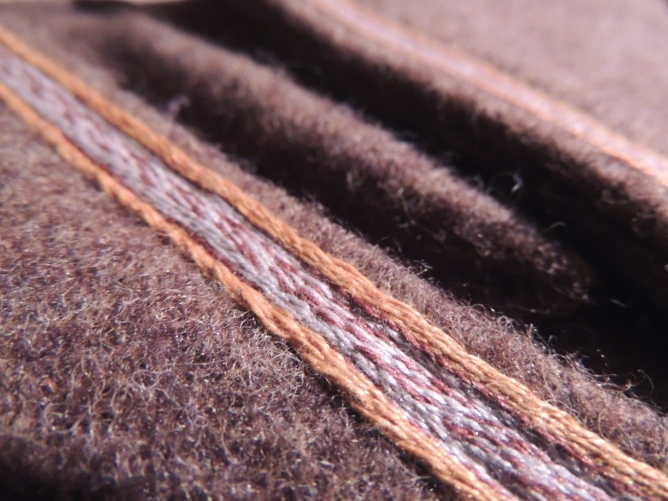



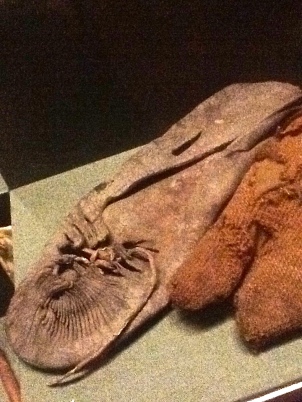



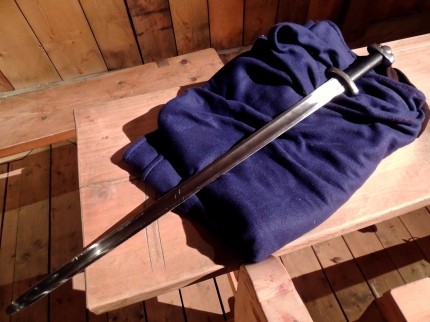

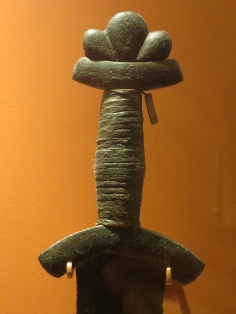



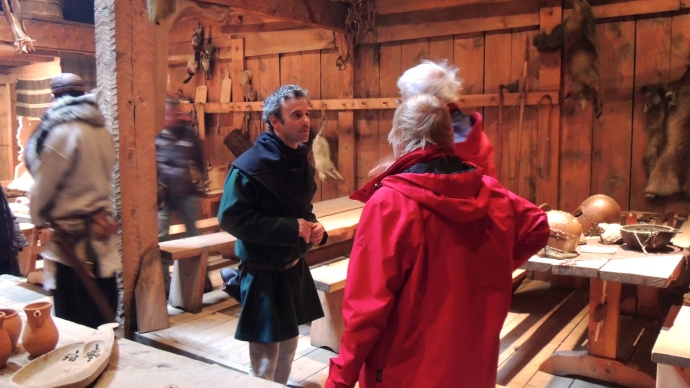



This is great reading, Mr Fox! I’m really glad I got the subscribtion “invitation”; I actually had no idea you even had this blog in the first place!
A number of questions arose when I read this post, but I’ll be back at Lofotr the 11th, so I hope that an occation where I may ask my questions will occure then.
In any case, I’ll await your next post with bated breath!
With the very best of regards,
Even
LikeLike
Thanks so much Even, yes I will have plenty of time to chat; just pull me to one side!
LikeLike
Reblogged this on emerfox and commented:
Very interesting article by Stephen.
LikeLike
This is lovely; I was a early medieval reenactor for about 10 years (I am on an extended break at the moment). I always loved the textile crafts the best, especially costume-making, weaving and tablet-weaving, more so than embroidery. The photos are beautiful, thanks for sharing!
LikeLiked by 1 person
Thanks! I’m also really enjoying this blogging business! 🙂
LikeLike
is the arm ring cast pewter?
In answer i think most vikings had thier clothes made by either mum or wife, possibly both, since mother and daughter in law would often ahve worked together
I’ve always found the public have quite a negative reaction to first person reenactors staying in charachter(children just find it confusing and annoying), you have to step out of it and find common ground so they can relate the archaeology to an equivalent aspect of thier everyday life
LikeLike
Yes you are absolutely correct, I am discovering that for myself now too. Half and half.
LikeLike
That’s a very interesting read. How do you go about volunteering at the museum? I’m a self-employed historical interpreter, so it would be great to know what they pay for expenses, and how long the waiting list is.
LikeLiked by 1 person
Hi there, I am not a volunteer here, I am a member of staff as a Crafter and Guide. Its not so much a waiting list as it is what you can offer the museum. Each summer season starts around May and ends mid August sot check out the Lofotr Viking Museum website and get a cv in early I would suggest.
LikeLiked by 1 person
Thanks for the info. I’ll do that.
LikeLike
great blog!! love the clothing… where could I find patterns for the clothing… especially love the shirt and tunic… even the pants look great and all sooooo comfortable looking too!
cheers from Down Under… a long way from anything viking 🙂
LikeLike
Now this is just up my street as they say !. In my opinion Re-enactors bring the whole site to life. Loved reading this post and seeing glorious photo’s How rewarding your work is for you. Love the complete Viking outfit. Looking forward to reading more.
LikeLiked by 1 person
Thanks for you lovely comments. I have been very busy with beginning my PhD. Hopefully I will have time over Christmas, in my next story I make a Viking bow 🙂
LikeLike
Hi Stephen, I forgot to ask if you know of The Yorvik Viking Centre in Yorkshire England. They have a complete village scene set up there with the sounds and smells of the times. Thanks for the follow by the way.
LikeLike
I have seen the Jorvik centre, very fun place! Keep in touch with your work on Minoan archaeology will you?
LikeLike
I sure will .! Stephen I shall be interested to know whether you decide to start working on building up a Museum there. However you sound busy for now. I am looking forward to reading more of your posts.
LikeLike
There isn’t much experience of 1st person reenactment in Ireland, but it actually works to sensational effect at a place called Kentwell in England, where they’ve been doing 16th century living history for almost 40 years. Visitors walk through a time tunnel and are transported back to a specific year in the 16th century. Food is cooked and crafts are made and all the while people are speaking in 16th century speech patterns and when asked who they are, every person has a back story. I was reenacting for 7 years in Ireland before I started doing Kentwell and was pleasantly surprised to see how well it worked. I think there’s a time and a place for both techniques. It’s easier to do 1st person when you are in the perfect setting, but not every period is so easy to do 1st person in. 16th century English is relatively easy to understand, even to our modern ears. Not everybody can improvise on the spot and might find it stressful to have to make up and remember a back story.
LikeLike
Very interesting! Thanks for sharing Melissa! Yes, I completely failed at being a ‘character’. I just couldn’t do it. My expertise is in the science of experimental archaeology, and speaking about the past, pretending to be a character completely crippled my ability to communicate, so, I just didn’t pretend. It is a reconstructed longhouse, but it is also a museum, with the original house marked right it outside the door. We have a responsibility to the archaeology firsts my opinion. This period is very difficult to pul together, and most of the staff aren’t trained historians or archaeologists, but hired for their multiple languages which is extremely important. So the most worrying thing I witnessed, was that when a ‘character’ was confronted with a question he or she couldn’t answer, in some cases they would invent, even lie about aspects of daily life. I mean what else can they do without breaking character. I don’t think it was necessary, it didn’t work here. Glad you liked my post 🙂
LikeLike
Pingback: The Things We Wear, The Trinkets We Carry | ArchaeoFox: Exploring the World Through the Past | P'andar
Reblogged and linked in my blog Mujerárbol, Mr. Fox. Absolutely grand post and gorgeous photos. Craving to see the museum… maybe some day.
LikeLiked by 1 person
Thank you so much, there are more photos of my current activities in Experimental Archaeology in the photography section of my homepage. Thanks for the comment 🙂
LikeLike
Pingback: The Things We Wear, The Trinkets We Carry | ArchaeoFox: Exploring the World Through the Past | Mujerárbol